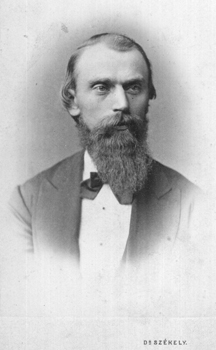Gustavus Detlef Hinrichs
Gustavus Detlef Hinrichs (born December 2, 1836 in Lunden , Holstein, † February 14, 1923 in St. Louis , USA) was a chemist.
Life
His parents were Johann Detlev Hinrichs and Caroline Catharine Elizabeth, the daughter of the Danish officer Carl Gustav Andersen. At the age of 13 he ran away from home to support the Germans against the integration of Schleswig into Denmark. In July he took part in the battle of Idstedt as a drummer boy . From 1853 to 1856 he was a student at the Polytechnic School and then studied mathematics, physics and chemistry at the University of Copenhagen. In Copenhagen he was friends with Hans Christian Andersen . Last year he was assistant to the biologist Daniel Frederik Eschricht (1798–1863). In April 1860 he married Auguste C. F. Springer (1839-1865) from Rendsburg.
In the summer of 1861 he emigrated to the USA, possibly because he did not want to serve in the Danish army. He settled in Davenport, Iowa and taught first at a county school and later at high school.
In August 1863 he became a modern language teacher at the University of Iowa . In June 1864 he became professor of physics in the Department of Chemistry and Natural Philosophy . He also became director of the laboratory and professor of chemistry in the medical school.
After the death of his wife, with whom he had children Gustavus John (farmer) and Anna (musician and author), he married her younger sister Anna Catharina Springer (1842–1910) in 1867. Her son was Carl Gustave (chemist).
In 1868 he also became a chemist for the United States Geological Survey . He received his AM from Griswold College in Poultney, Vermont in 1870, his MD from Missouri Medical College in 1872 and his LL.D. in 1884. at Griswold College.
In the 1870s he published The American Scientific Monthly . In 1875 he organized the first US weather service in Iowa, which he initially financed privately and which he was director until 1889.
From the 1870s onwards, the university's financial resources were cut. In 1885/86 he had to give up his chair in Iowa for religious and political reasons.
In 1889 he became Professor of Chemistry at the College of Pharmacy in St. Louis and in 1903 Professor of Chemistry at the Medical Faculty of the University of St. Louis. In 1907 he retires.
At a young age he developed a hypothesis about a primal substance which, as Leibnitz already called pantogen . Since chlorine had an atomic mass of 35.5, he concluded that this primal substance must have half the atomic mass of hydrogen . From this idea he developed a spiral period table by 1867.
In 1864 he tried an early version of the periodic table with a spiral arrangement. The integer ratios in spectra reminded him of the ratios of the distances in planetary systems and he saw this as an indication of atomic orders of magnitude.
Fonts
- The Elements of Chemistry and Mineralogy . Day, Egbert & Fidlar, Davenport IA 1871
- The Principles of Chemistry and Molecular Mechanics . Day, Egbert & Fidlar, Davenport IA 1874
literature
- Gregor Brand: Hinrichs, Gustav Dethlef. In: Biographisch-Bibliographisches Kirchenlexikon (BBKL). Volume 22, Bautz, Nordhausen 2003, ISBN 3-88309-133-2 , Sp. 531-541.
- Carl A. Zapffe: Hinrichs, Precursor of Mendeleev Isis, Volume 60, 1969, pp. 461-476
Individual evidence
- ↑ Gustavus Hinrichs Papers. The University Library of Iowa
- ↑ Hinrichs, Gustavus Detlef . In: James Grant Wilson, John Fiske (Eds.): Appletons' Cyclopædia of American Biography . tape 3 : Grinnell - Lockwood . D. Appleton and Company, New York 1887, p. 215 (English, full text [ Wikisource ]).
- ^ WP Palmer: Dissent at The University of Iowa: Gustavus Detlev Hinrichs - Chemist and Polymath . (PDF; 208 kB)
- ^ The Crystallographic Work Of Gustavus Hinrichs . Volume 9, 1924, pp. 5-8, Charles Keyes, Des Moines IA
- ↑ Scerri, Mendeleev's Legacy: The Periodic System. Distillations, 2007
| personal data | |
|---|---|
| SURNAME | Hinrichs, Gustavus Detlef |
| ALTERNATIVE NAMES | Hinrichs, Gustav Dethlef |
| BRIEF DESCRIPTION | Holstein, American chemist |
| DATE OF BIRTH | December 2, 1836 |
| PLACE OF BIRTH | Lunden |
| DATE OF DEATH | February 14, 1923 |
| Place of death | St. Louis |
